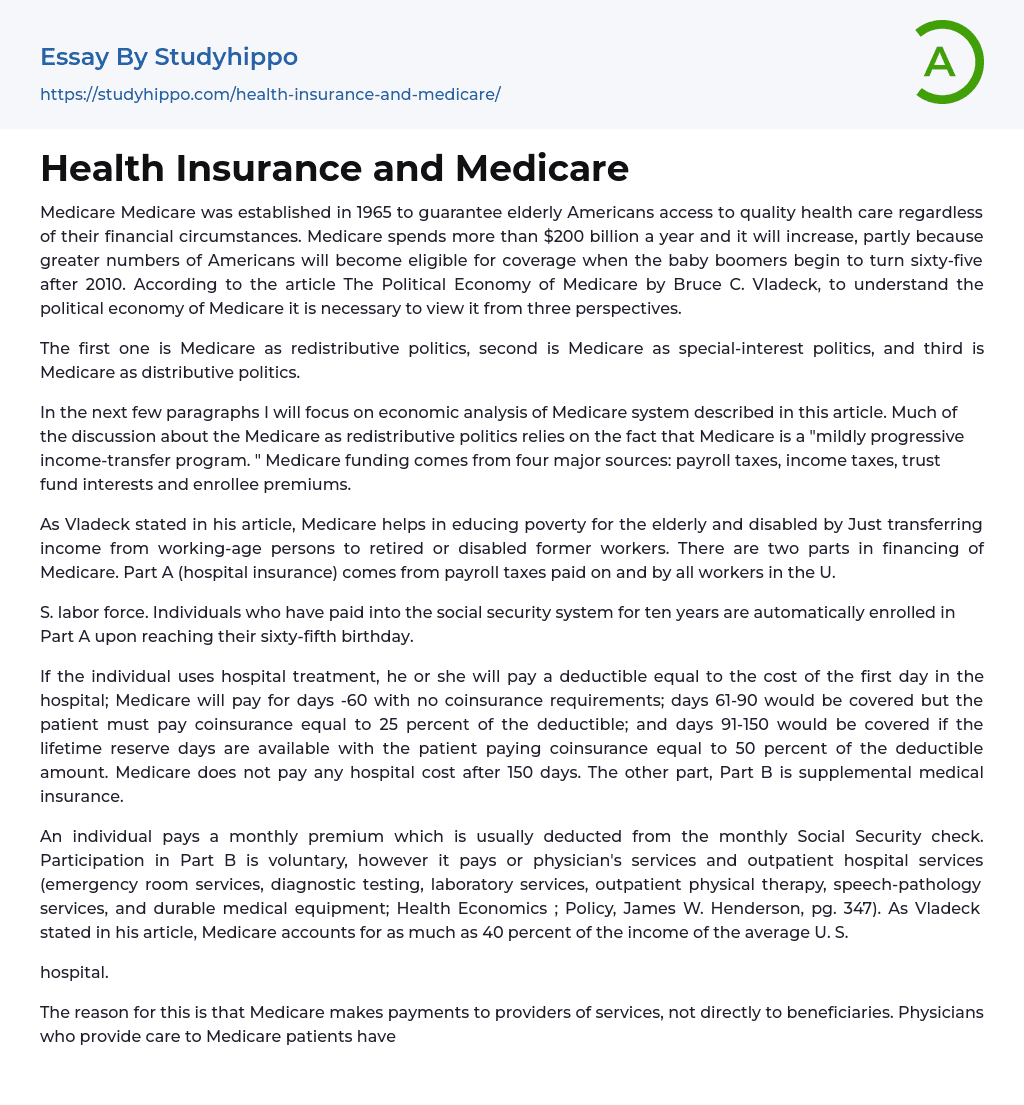Established in 1965, Medicare's aim is to provide accessible and high-quality healthcare services to elderly citizens regardless of their financial situation. The program's annual expenses are expected to surpass $200 billion due to an increasing number of Americans becoming eligible for coverage, particularly baby boomers who reach age 65 after 2010. In "The Political Economy of Medicare," Bruce C. Vladeck outlines three perspectives on understanding Medicare's political economy: redistributive politics, special-interest politics, and distributive politics. Thisfocuses on the economic analysis presented by Vladeck which explains how Medicare functions as a somewhat progressive income-transfer initiative fueled by four main sources - payroll taxes, income taxes, trust fund interests, and premium payments from enrollees. By transferring earnings from working-age individuals to retired or disabled former workers through income redistribution, Medicare helps reduce poverty among elderly and disable
...d populations. The funding model for hospital insurance (Part A) relies on payroll taxes from the US labor force and other revenue streams with individuals automatically enrolled upon turning 65 years old after contributing to the social security system for ten years; however, there is a deductible payment required for hospital treatment equaling the initial hospital day cost.Medicare covers days one through sixty without coinsurance requirements, but days sixty-one through ninety require twenty-five percent coinsurance equivalent to the deductible. If lifetime reserve days are available between days ninety-one through one hundred fifty, coinsurance is fifty percent of the deductible; however, there is no coverage beyond that point. Optional Part B enrollment includes monthly premiums deducted from Social Security checks and covers outpatient medical services like emergency room visits, diagnostic testing, laboratory work, physical therapy, speech pathology services, and long-term medical equipment
rental. Payments go directly to service providers rather than beneficiaries. Vladeck reports that Medicare accounts for up to forty percent of income for average US hospitals. Physicians treating patients under this plan must decide whether to accept the Medicare allowable fee or use balance billing when their fees exceed the maximum charge allowed by their specific plan. Nonetheless, many physicians argue that these allowable fees are below actual service costs which results in shifting expenses onto private patients. Hospitals' payment system is determined beforehand through the prospective payment system (PPS), particularly teaching ones; while many managed care organizations base their payments on capitation.In his analysis, Vladeck scrutinizes the impact of Medicare contractors - privately-owned insurance firms that oversee administrative tasks - on Medicare through interest-group politics. The retrospective fee-for-service model enables providers to pass on all expenses indiscriminately without consideration for production efficiency. This results in patients having no motivation to seek more affordable healthcare services. Within the political system, Vladeck emphasizes that various stakeholders such as Medicare contractors, hospitals, doctors and HMOs have a significant interest in Medicare policy and behave accordingly. Concerning distributive politics related to Medicare, there is an issue with the distribution of funds across areas due to payment rates under capitated plans based on the Balance Budget Act. Distributing payments justly under capitation where healthcare providers receive a fixed cost per person for medical benefits is complicated by market fluctuations influenced by price changes. Healthcare expenditure responsibilities must be assumed by Americans if future modifications are made by 2010 regarding Medicare policies. An avenue for increasing disposable income towards covering high deductibles could be contributing to Medical Savings Accounts (MSAs),
but low-income earners may struggle with contributions and experience financial difficulties when paying out-of-pocket medical bills.Despite ongoing debates, the government plans to promote MSAs for expanding healthcare coverage. These are savings accounts that cover medical expenses not included in insurance plans and allow accountholders to save money on medical expenses through tax-deductible contributions. Self-employed individuals can accumulate funds over time or employers can contribute on behalf of their employees. To qualify, individuals need high-deductible medical insurance for extreme situations. Some critics argue that higher earners may benefit more from MSAs than lower earners due to their financial capabilities. However, the government considers this system feasible in making healthcare accessible for all.
- Hospital essays
- Physician essays
- Health Care Provider essays
- Universal Health Care essays
- Readmission essays
- Addiction essays
- Anatomy and Physiology essays
- Biodegradation essays
- Cancer essays
- Dental Care essays
- Disability essays
- Disease essays
- Disorders essays
- Health Care essays
- Infectious Disease essays
- Inquiry essays
- Intelligence Quotient essays
- Lung Cancer essays
- Medicine essays
- Neurology essays
- Nutrition essays
- Olfaction essays
- Physical Exercise essays
- Public Health essays
- Sex essays
- Women's Health essays
- World health organization essays
- John Locke essays
- 9/11 essays
- A Good Teacher essays
- A Healthy Diet essays
- A Modest Proposal essays
- A&P essays
- Academic Achievement essays
- Achievement essays
- Achieving goals essays
- Admission essays
- Advantages And Disadvantages Of Internet essays
- Alcoholic drinks essays
- Ammonia essays
- Analytical essays
- Ancient Olympic Games essays
- APA essays
- Arabian Peninsula essays
- Argument essays
- Argumentative essays
- Art essays
- Atlantic Ocean essays
- Auto-ethnography essays
- Autobiography essays




